Business Environment Analysis Report: Marks & Spencer and NHS
VerifiedAdded on 2020/06/04
|9
|2836
|29
Report
AI Summary
This report provides a comprehensive analysis of the business environment, focusing on Marks & Spencer (M&S) and the National Health Service (NHS). It begins by defining different types of businesses, their purposes, and ownership structures, comparing M&S as a public limited company in the tertiary sector with the NHS, a national not-for-profit organization owned by the government. The report then explores the impact of various stakeholders, including customers, employees, and suppliers, on the purpose of a business. It further delves into the organizational structures of both businesses, detailing functional, geographic, and matrix structures, and how these structures help them fulfill their objectives. The report also examines the influence of economic environments, specifically economic growth and recession, on M&S, and the impact of political, legal, and social factors on business activities. It includes examples such as minimum wage increases and their effects on consumer spending and business profitability. The report concludes by summarizing the key findings and insights into the complex interplay of factors shaping the business environment.
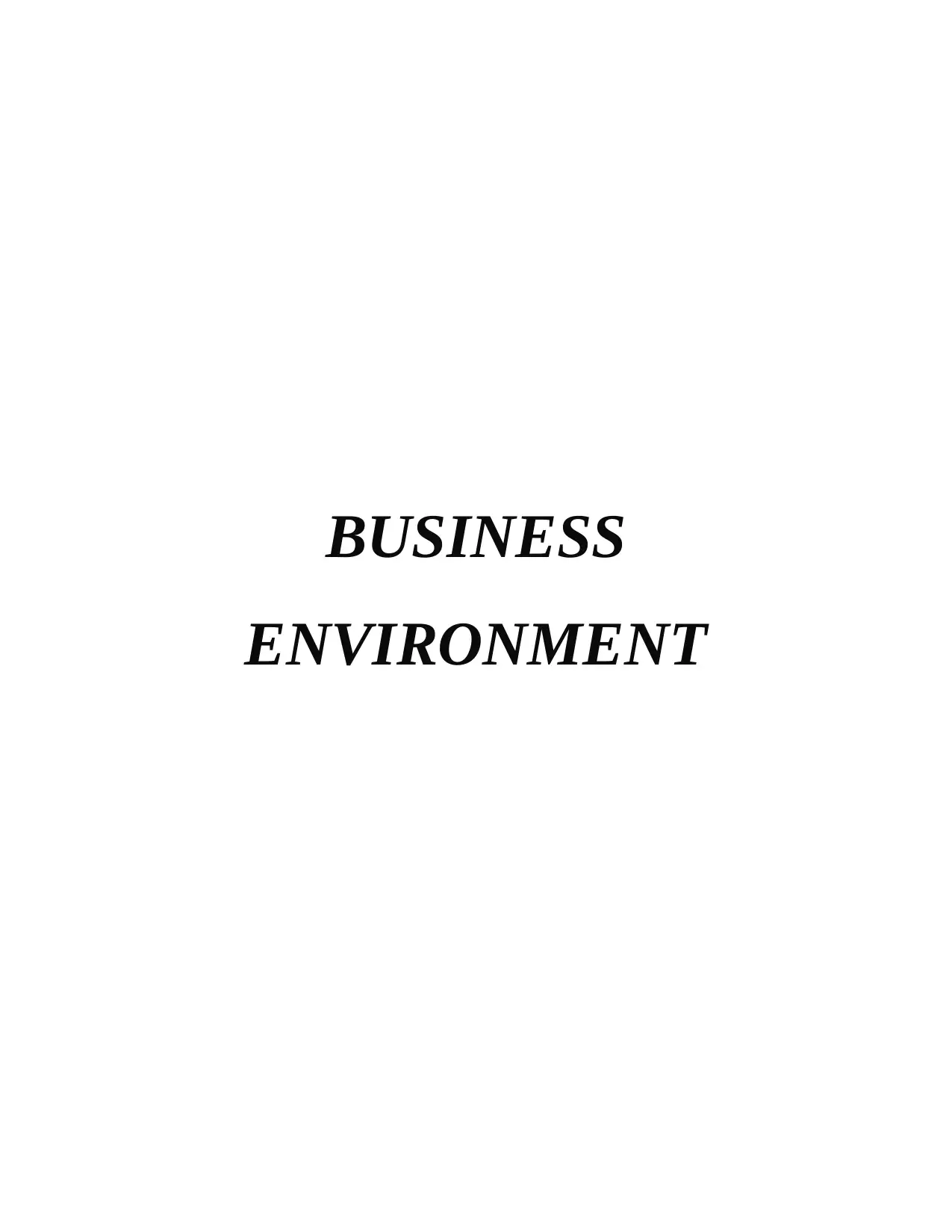
BUSINESS
ENVIRONMENT
ENVIRONMENT
Paraphrase This Document
Need a fresh take? Get an instant paraphrase of this document with our AI Paraphraser
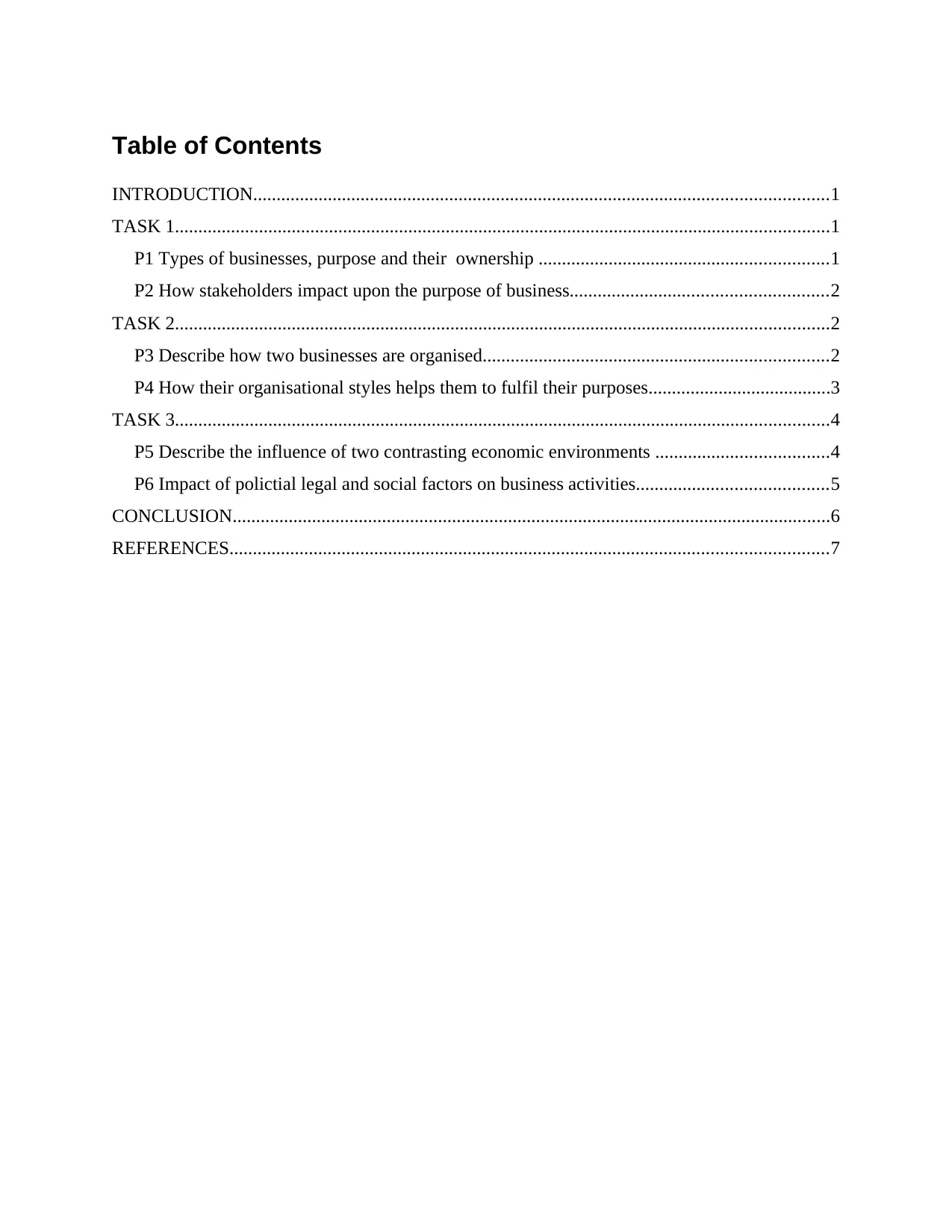
Table of Contents
INTRODUCTION...........................................................................................................................1
TASK 1............................................................................................................................................1
P1 Types of businesses, purpose and their ownership ..............................................................1
P2 How stakeholders impact upon the purpose of business.......................................................2
TASK 2............................................................................................................................................2
P3 Describe how two businesses are organised..........................................................................2
P4 How their organisational styles helps them to fulfil their purposes.......................................3
TASK 3............................................................................................................................................4
P5 Describe the influence of two contrasting economic environments .....................................4
P6 Impact of polictial legal and social factors on business activities.........................................5
CONCLUSION................................................................................................................................6
REFERENCES................................................................................................................................7
INTRODUCTION...........................................................................................................................1
TASK 1............................................................................................................................................1
P1 Types of businesses, purpose and their ownership ..............................................................1
P2 How stakeholders impact upon the purpose of business.......................................................2
TASK 2............................................................................................................................................2
P3 Describe how two businesses are organised..........................................................................2
P4 How their organisational styles helps them to fulfil their purposes.......................................3
TASK 3............................................................................................................................................4
P5 Describe the influence of two contrasting economic environments .....................................4
P6 Impact of polictial legal and social factors on business activities.........................................5
CONCLUSION................................................................................................................................6
REFERENCES................................................................................................................................7
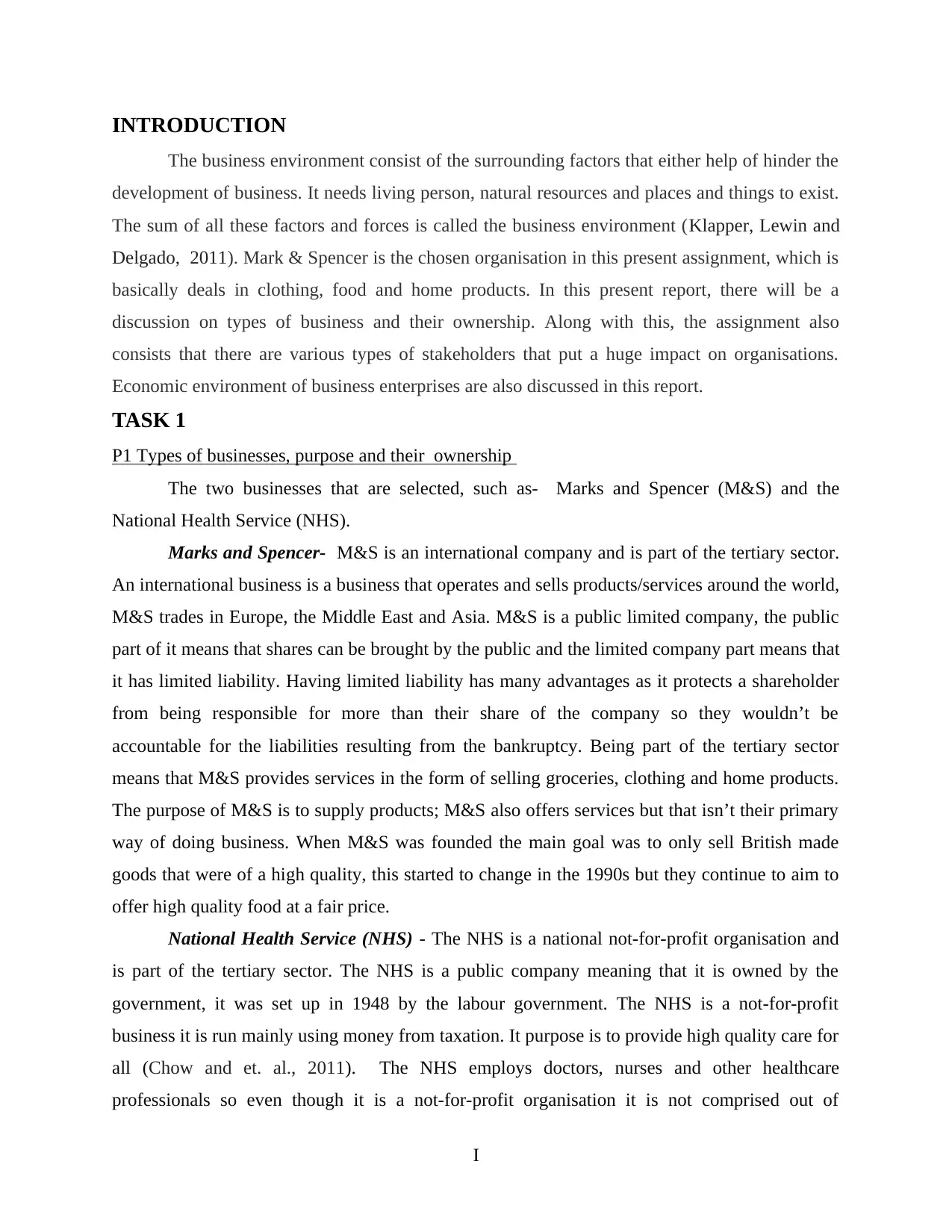
INTRODUCTION
The business environment consist of the surrounding factors that either help of hinder the
development of business. It needs living person, natural resources and places and things to exist.
The sum of all these factors and forces is called the business environment (Klapper, Lewin and
Delgado, 2011). Mark & Spencer is the chosen organisation in this present assignment, which is
basically deals in clothing, food and home products. In this present report, there will be a
discussion on types of business and their ownership. Along with this, the assignment also
consists that there are various types of stakeholders that put a huge impact on organisations.
Economic environment of business enterprises are also discussed in this report.
TASK 1
P1 Types of businesses, purpose and their ownership
The two businesses that are selected, such as- Marks and Spencer (M&S) and the
National Health Service (NHS).
Marks and Spencer- M&S is an international company and is part of the tertiary sector.
An international business is a business that operates and sells products/services around the world,
M&S trades in Europe, the Middle East and Asia. M&S is a public limited company, the public
part of it means that shares can be brought by the public and the limited company part means that
it has limited liability. Having limited liability has many advantages as it protects a shareholder
from being responsible for more than their share of the company so they wouldn’t be
accountable for the liabilities resulting from the bankruptcy. Being part of the tertiary sector
means that M&S provides services in the form of selling groceries, clothing and home products.
The purpose of M&S is to supply products; M&S also offers services but that isn’t their primary
way of doing business. When M&S was founded the main goal was to only sell British made
goods that were of a high quality, this started to change in the 1990s but they continue to aim to
offer high quality food at a fair price.
National Health Service (NHS) - The NHS is a national not-for-profit organisation and
is part of the tertiary sector. The NHS is a public company meaning that it is owned by the
government, it was set up in 1948 by the labour government. The NHS is a not-for-profit
business it is run mainly using money from taxation. It purpose is to provide high quality care for
all (Chow and et. al., 2011). The NHS employs doctors, nurses and other healthcare
professionals so even though it is a not-for-profit organisation it is not comprised out of
I
The business environment consist of the surrounding factors that either help of hinder the
development of business. It needs living person, natural resources and places and things to exist.
The sum of all these factors and forces is called the business environment (Klapper, Lewin and
Delgado, 2011). Mark & Spencer is the chosen organisation in this present assignment, which is
basically deals in clothing, food and home products. In this present report, there will be a
discussion on types of business and their ownership. Along with this, the assignment also
consists that there are various types of stakeholders that put a huge impact on organisations.
Economic environment of business enterprises are also discussed in this report.
TASK 1
P1 Types of businesses, purpose and their ownership
The two businesses that are selected, such as- Marks and Spencer (M&S) and the
National Health Service (NHS).
Marks and Spencer- M&S is an international company and is part of the tertiary sector.
An international business is a business that operates and sells products/services around the world,
M&S trades in Europe, the Middle East and Asia. M&S is a public limited company, the public
part of it means that shares can be brought by the public and the limited company part means that
it has limited liability. Having limited liability has many advantages as it protects a shareholder
from being responsible for more than their share of the company so they wouldn’t be
accountable for the liabilities resulting from the bankruptcy. Being part of the tertiary sector
means that M&S provides services in the form of selling groceries, clothing and home products.
The purpose of M&S is to supply products; M&S also offers services but that isn’t their primary
way of doing business. When M&S was founded the main goal was to only sell British made
goods that were of a high quality, this started to change in the 1990s but they continue to aim to
offer high quality food at a fair price.
National Health Service (NHS) - The NHS is a national not-for-profit organisation and
is part of the tertiary sector. The NHS is a public company meaning that it is owned by the
government, it was set up in 1948 by the labour government. The NHS is a not-for-profit
business it is run mainly using money from taxation. It purpose is to provide high quality care for
all (Chow and et. al., 2011). The NHS employs doctors, nurses and other healthcare
professionals so even though it is a not-for-profit organisation it is not comprised out of
I
⊘ This is a preview!⊘
Do you want full access?
Subscribe today to unlock all pages.

Trusted by 1+ million students worldwide
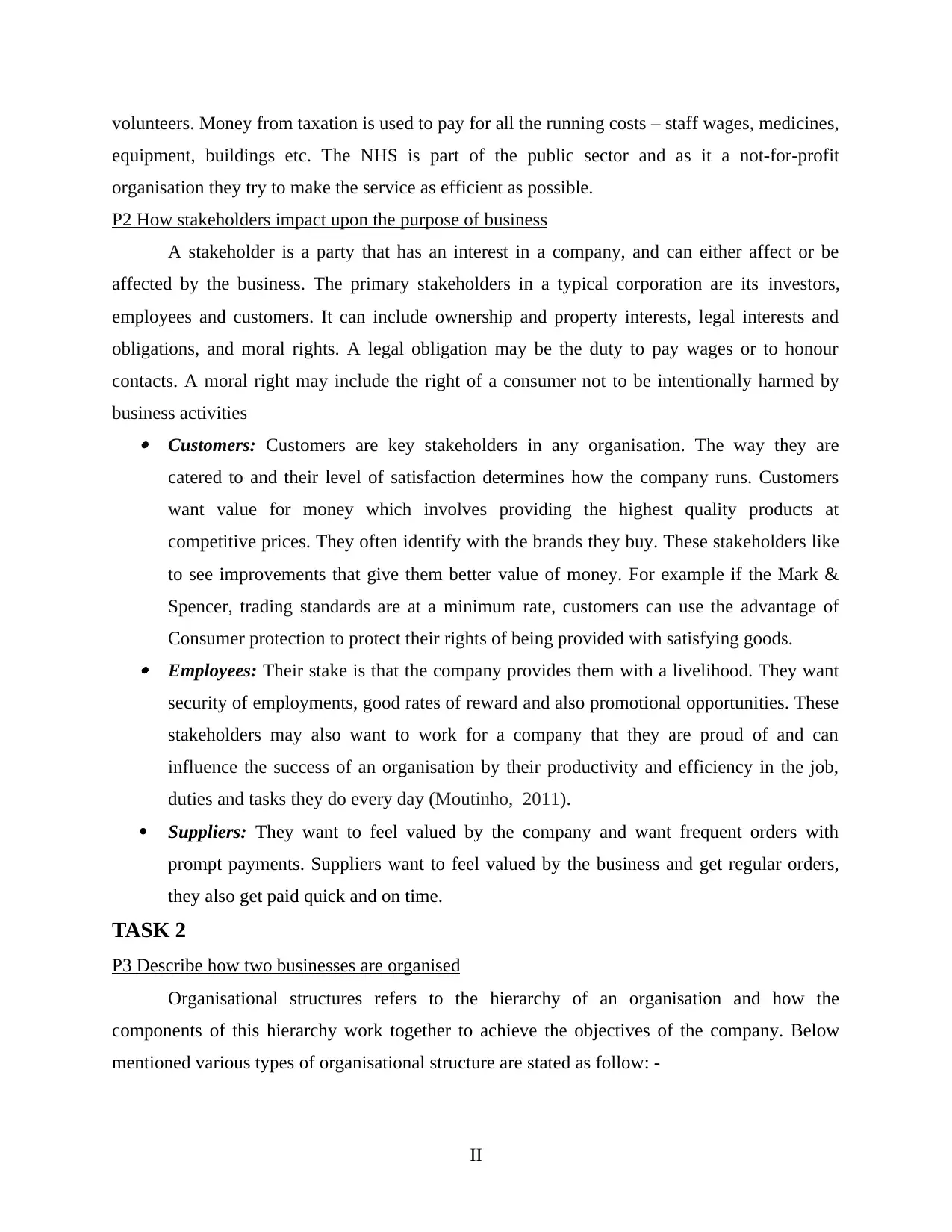
volunteers. Money from taxation is used to pay for all the running costs – staff wages, medicines,
equipment, buildings etc. The NHS is part of the public sector and as it a not-for-profit
organisation they try to make the service as efficient as possible.
P2 How stakeholders impact upon the purpose of business
A stakeholder is a party that has an interest in a company, and can either affect or be
affected by the business. The primary stakeholders in a typical corporation are its investors,
employees and customers. It can include ownership and property interests, legal interests and
obligations, and moral rights. A legal obligation may be the duty to pay wages or to honour
contacts. A moral right may include the right of a consumer not to be intentionally harmed by
business activities Customers: Customers are key stakeholders in any organisation. The way they are
catered to and their level of satisfaction determines how the company runs. Customers
want value for money which involves providing the highest quality products at
competitive prices. They often identify with the brands they buy. These stakeholders like
to see improvements that give them better value of money. For example if the Mark &
Spencer, trading standards are at a minimum rate, customers can use the advantage of
Consumer protection to protect their rights of being provided with satisfying goods. Employees: Their stake is that the company provides them with a livelihood. They want
security of employments, good rates of reward and also promotional opportunities. These
stakeholders may also want to work for a company that they are proud of and can
influence the success of an organisation by their productivity and efficiency in the job,
duties and tasks they do every day (Moutinho, 2011).
Suppliers: They want to feel valued by the company and want frequent orders with
prompt payments. Suppliers want to feel valued by the business and get regular orders,
they also get paid quick and on time.
TASK 2
P3 Describe how two businesses are organised
Organisational structures refers to the hierarchy of an organisation and how the
components of this hierarchy work together to achieve the objectives of the company. Below
mentioned various types of organisational structure are stated as follow: -
II
equipment, buildings etc. The NHS is part of the public sector and as it a not-for-profit
organisation they try to make the service as efficient as possible.
P2 How stakeholders impact upon the purpose of business
A stakeholder is a party that has an interest in a company, and can either affect or be
affected by the business. The primary stakeholders in a typical corporation are its investors,
employees and customers. It can include ownership and property interests, legal interests and
obligations, and moral rights. A legal obligation may be the duty to pay wages or to honour
contacts. A moral right may include the right of a consumer not to be intentionally harmed by
business activities Customers: Customers are key stakeholders in any organisation. The way they are
catered to and their level of satisfaction determines how the company runs. Customers
want value for money which involves providing the highest quality products at
competitive prices. They often identify with the brands they buy. These stakeholders like
to see improvements that give them better value of money. For example if the Mark &
Spencer, trading standards are at a minimum rate, customers can use the advantage of
Consumer protection to protect their rights of being provided with satisfying goods. Employees: Their stake is that the company provides them with a livelihood. They want
security of employments, good rates of reward and also promotional opportunities. These
stakeholders may also want to work for a company that they are proud of and can
influence the success of an organisation by their productivity and efficiency in the job,
duties and tasks they do every day (Moutinho, 2011).
Suppliers: They want to feel valued by the company and want frequent orders with
prompt payments. Suppliers want to feel valued by the business and get regular orders,
they also get paid quick and on time.
TASK 2
P3 Describe how two businesses are organised
Organisational structures refers to the hierarchy of an organisation and how the
components of this hierarchy work together to achieve the objectives of the company. Below
mentioned various types of organisational structure are stated as follow: -
II
Paraphrase This Document
Need a fresh take? Get an instant paraphrase of this document with our AI Paraphraser
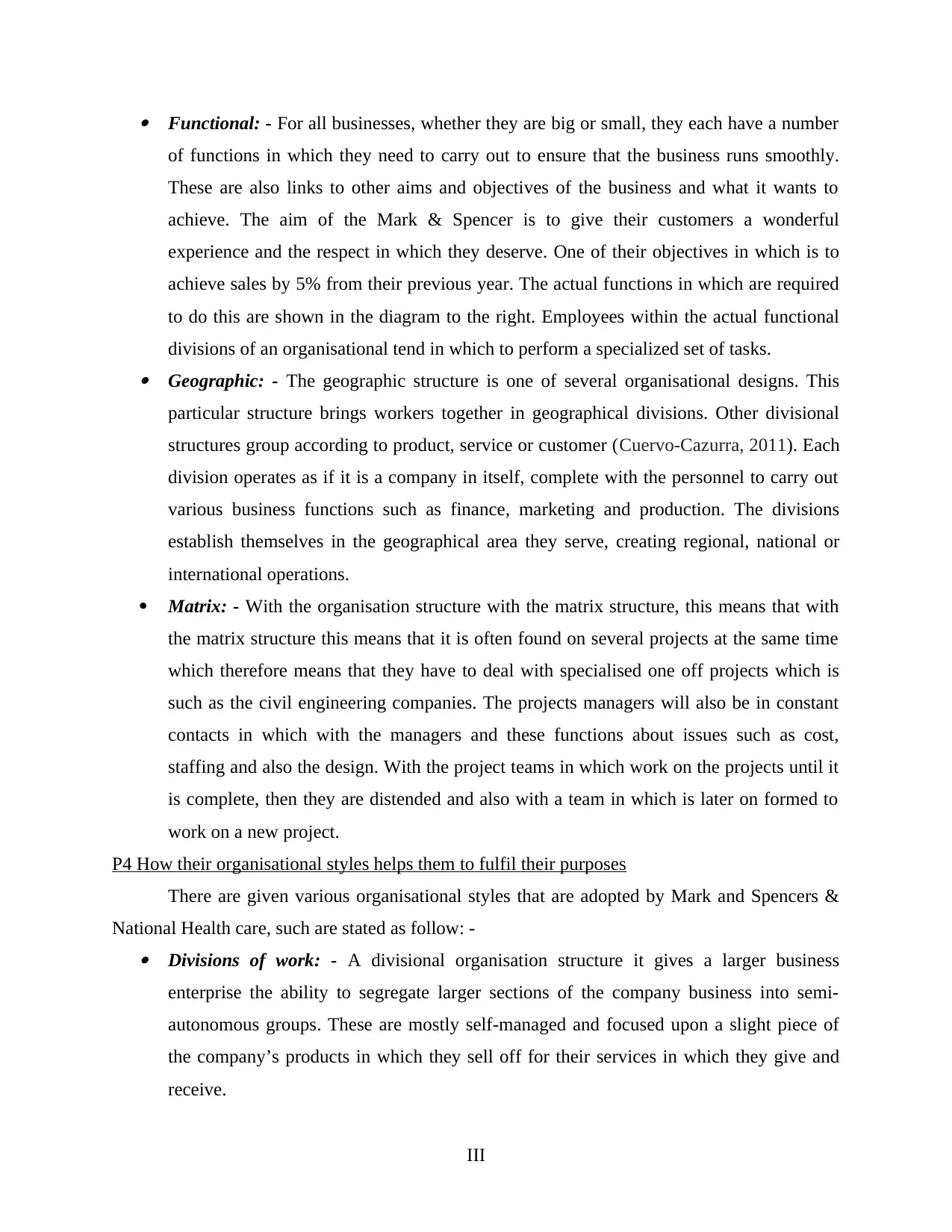
Functional: - For all businesses, whether they are big or small, they each have a number
of functions in which they need to carry out to ensure that the business runs smoothly.
These are also links to other aims and objectives of the business and what it wants to
achieve. The aim of the Mark & Spencer is to give their customers a wonderful
experience and the respect in which they deserve. One of their objectives in which is to
achieve sales by 5% from their previous year. The actual functions in which are required
to do this are shown in the diagram to the right. Employees within the actual functional
divisions of an organisational tend in which to perform a specialized set of tasks. Geographic: - The geographic structure is one of several organisational designs. This
particular structure brings workers together in geographical divisions. Other divisional
structures group according to product, service or customer (Cuervo‐Cazurra, 2011). Each
division operates as if it is a company in itself, complete with the personnel to carry out
various business functions such as finance, marketing and production. The divisions
establish themselves in the geographical area they serve, creating regional, national or
international operations.
Matrix: - With the organisation structure with the matrix structure, this means that with
the matrix structure this means that it is often found on several projects at the same time
which therefore means that they have to deal with specialised one off projects which is
such as the civil engineering companies. The projects managers will also be in constant
contacts in which with the managers and these functions about issues such as cost,
staffing and also the design. With the project teams in which work on the projects until it
is complete, then they are distended and also with a team in which is later on formed to
work on a new project.
P4 How their organisational styles helps them to fulfil their purposes
There are given various organisational styles that are adopted by Mark and Spencers &
National Health care, such are stated as follow: - Divisions of work: - A divisional organisation structure it gives a larger business
enterprise the ability to segregate larger sections of the company business into semi-
autonomous groups. These are mostly self-managed and focused upon a slight piece of
the company’s products in which they sell off for their services in which they give and
receive.
III
of functions in which they need to carry out to ensure that the business runs smoothly.
These are also links to other aims and objectives of the business and what it wants to
achieve. The aim of the Mark & Spencer is to give their customers a wonderful
experience and the respect in which they deserve. One of their objectives in which is to
achieve sales by 5% from their previous year. The actual functions in which are required
to do this are shown in the diagram to the right. Employees within the actual functional
divisions of an organisational tend in which to perform a specialized set of tasks. Geographic: - The geographic structure is one of several organisational designs. This
particular structure brings workers together in geographical divisions. Other divisional
structures group according to product, service or customer (Cuervo‐Cazurra, 2011). Each
division operates as if it is a company in itself, complete with the personnel to carry out
various business functions such as finance, marketing and production. The divisions
establish themselves in the geographical area they serve, creating regional, national or
international operations.
Matrix: - With the organisation structure with the matrix structure, this means that with
the matrix structure this means that it is often found on several projects at the same time
which therefore means that they have to deal with specialised one off projects which is
such as the civil engineering companies. The projects managers will also be in constant
contacts in which with the managers and these functions about issues such as cost,
staffing and also the design. With the project teams in which work on the projects until it
is complete, then they are distended and also with a team in which is later on formed to
work on a new project.
P4 How their organisational styles helps them to fulfil their purposes
There are given various organisational styles that are adopted by Mark and Spencers &
National Health care, such are stated as follow: - Divisions of work: - A divisional organisation structure it gives a larger business
enterprise the ability to segregate larger sections of the company business into semi-
autonomous groups. These are mostly self-managed and focused upon a slight piece of
the company’s products in which they sell off for their services in which they give and
receive.
III
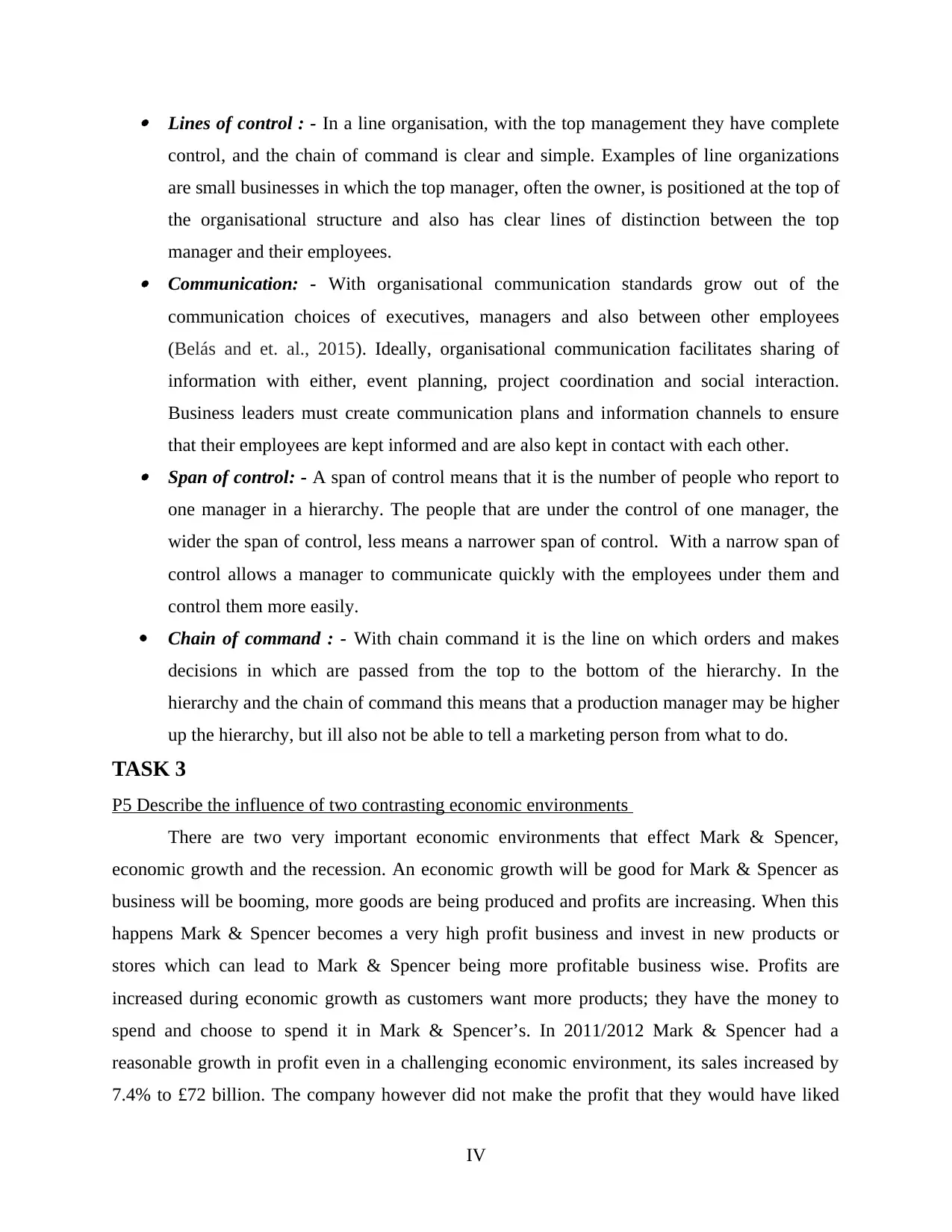
Lines of control : - In a line organisation, with the top management they have complete
control, and the chain of command is clear and simple. Examples of line organizations
are small businesses in which the top manager, often the owner, is positioned at the top of
the organisational structure and also has clear lines of distinction between the top
manager and their employees. Communication: - With organisational communication standards grow out of the
communication choices of executives, managers and also between other employees
(Belás and et. al., 2015). Ideally, organisational communication facilitates sharing of
information with either, event planning, project coordination and social interaction.
Business leaders must create communication plans and information channels to ensure
that their employees are kept informed and are also kept in contact with each other. Span of control: - A span of control means that it is the number of people who report to
one manager in a hierarchy. The people that are under the control of one manager, the
wider the span of control, less means a narrower span of control. With a narrow span of
control allows a manager to communicate quickly with the employees under them and
control them more easily.
Chain of command : - With chain command it is the line on which orders and makes
decisions in which are passed from the top to the bottom of the hierarchy. In the
hierarchy and the chain of command this means that a production manager may be higher
up the hierarchy, but ill also not be able to tell a marketing person from what to do.
TASK 3
P5 Describe the influence of two contrasting economic environments
There are two very important economic environments that effect Mark & Spencer,
economic growth and the recession. An economic growth will be good for Mark & Spencer as
business will be booming, more goods are being produced and profits are increasing. When this
happens Mark & Spencer becomes a very high profit business and invest in new products or
stores which can lead to Mark & Spencer being more profitable business wise. Profits are
increased during economic growth as customers want more products; they have the money to
spend and choose to spend it in Mark & Spencer’s. In 2011/2012 Mark & Spencer had a
reasonable growth in profit even in a challenging economic environment, its sales increased by
7.4% to £72 billion. The company however did not make the profit that they would have liked
IV
control, and the chain of command is clear and simple. Examples of line organizations
are small businesses in which the top manager, often the owner, is positioned at the top of
the organisational structure and also has clear lines of distinction between the top
manager and their employees. Communication: - With organisational communication standards grow out of the
communication choices of executives, managers and also between other employees
(Belás and et. al., 2015). Ideally, organisational communication facilitates sharing of
information with either, event planning, project coordination and social interaction.
Business leaders must create communication plans and information channels to ensure
that their employees are kept informed and are also kept in contact with each other. Span of control: - A span of control means that it is the number of people who report to
one manager in a hierarchy. The people that are under the control of one manager, the
wider the span of control, less means a narrower span of control. With a narrow span of
control allows a manager to communicate quickly with the employees under them and
control them more easily.
Chain of command : - With chain command it is the line on which orders and makes
decisions in which are passed from the top to the bottom of the hierarchy. In the
hierarchy and the chain of command this means that a production manager may be higher
up the hierarchy, but ill also not be able to tell a marketing person from what to do.
TASK 3
P5 Describe the influence of two contrasting economic environments
There are two very important economic environments that effect Mark & Spencer,
economic growth and the recession. An economic growth will be good for Mark & Spencer as
business will be booming, more goods are being produced and profits are increasing. When this
happens Mark & Spencer becomes a very high profit business and invest in new products or
stores which can lead to Mark & Spencer being more profitable business wise. Profits are
increased during economic growth as customers want more products; they have the money to
spend and choose to spend it in Mark & Spencer’s. In 2011/2012 Mark & Spencer had a
reasonable growth in profit even in a challenging economic environment, its sales increased by
7.4% to £72 billion. The company however did not make the profit that they would have liked
IV
⊘ This is a preview!⊘
Do you want full access?
Subscribe today to unlock all pages.

Trusted by 1+ million students worldwide
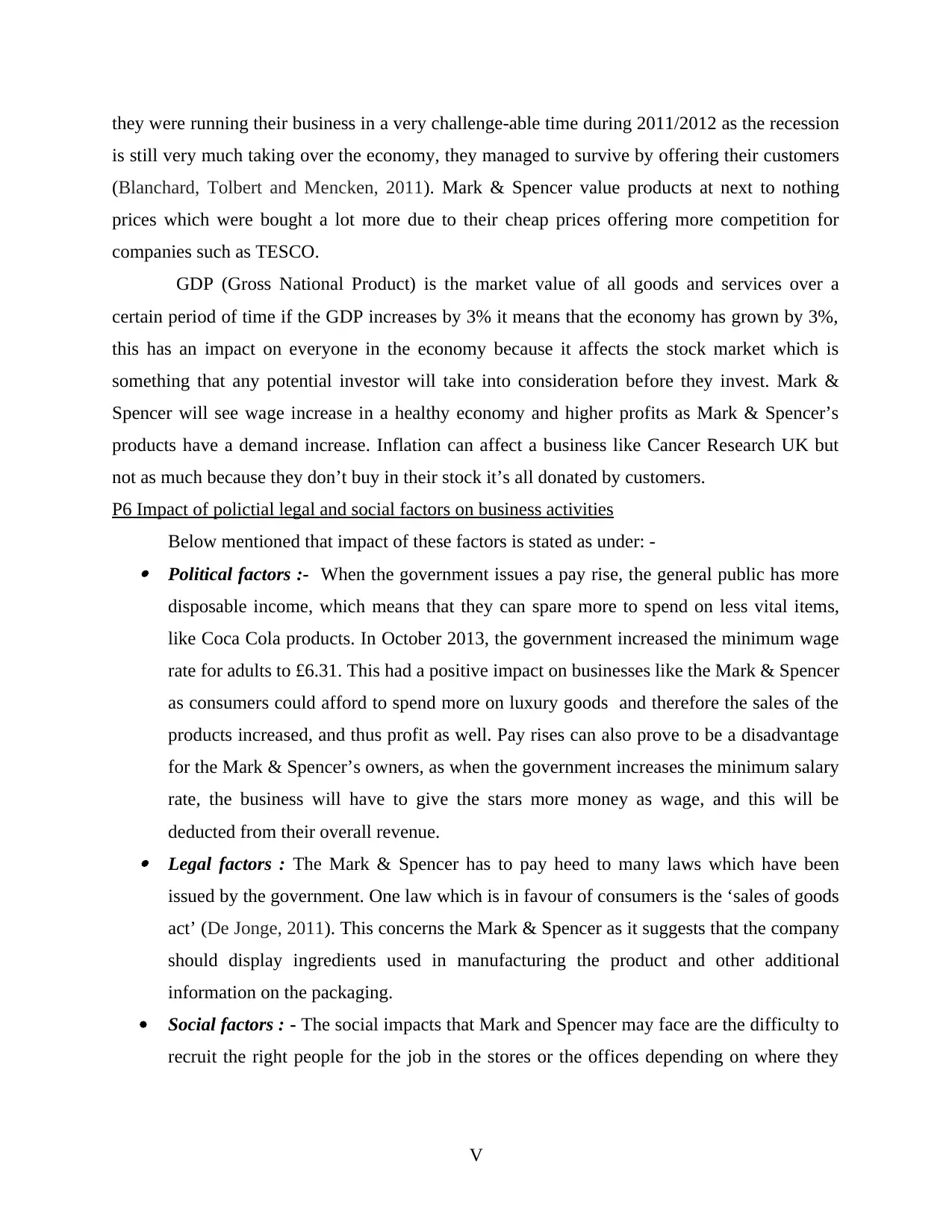
they were running their business in a very challenge-able time during 2011/2012 as the recession
is still very much taking over the economy, they managed to survive by offering their customers
(Blanchard, Tolbert and Mencken, 2011). Mark & Spencer value products at next to nothing
prices which were bought a lot more due to their cheap prices offering more competition for
companies such as TESCO.
GDP (Gross National Product) is the market value of all goods and services over a
certain period of time if the GDP increases by 3% it means that the economy has grown by 3%,
this has an impact on everyone in the economy because it affects the stock market which is
something that any potential investor will take into consideration before they invest. Mark &
Spencer will see wage increase in a healthy economy and higher profits as Mark & Spencer’s
products have a demand increase. Inflation can affect a business like Cancer Research UK but
not as much because they don’t buy in their stock it’s all donated by customers.
P6 Impact of polictial legal and social factors on business activities
Below mentioned that impact of these factors is stated as under: - Political factors :- When the government issues a pay rise, the general public has more
disposable income, which means that they can spare more to spend on less vital items,
like Coca Cola products. In October 2013, the government increased the minimum wage
rate for adults to £6.31. This had a positive impact on businesses like the Mark & Spencer
as consumers could afford to spend more on luxury goods and therefore the sales of the
products increased, and thus profit as well. Pay rises can also prove to be a disadvantage
for the Mark & Spencer’s owners, as when the government increases the minimum salary
rate, the business will have to give the stars more money as wage, and this will be
deducted from their overall revenue. Legal factors : The Mark & Spencer has to pay heed to many laws which have been
issued by the government. One law which is in favour of consumers is the ‘sales of goods
act’ (De Jonge, 2011). This concerns the Mark & Spencer as it suggests that the company
should display ingredients used in manufacturing the product and other additional
information on the packaging.
Social factors : - The social impacts that Mark and Spencer may face are the difficulty to
recruit the right people for the job in the stores or the offices depending on where they
V
is still very much taking over the economy, they managed to survive by offering their customers
(Blanchard, Tolbert and Mencken, 2011). Mark & Spencer value products at next to nothing
prices which were bought a lot more due to their cheap prices offering more competition for
companies such as TESCO.
GDP (Gross National Product) is the market value of all goods and services over a
certain period of time if the GDP increases by 3% it means that the economy has grown by 3%,
this has an impact on everyone in the economy because it affects the stock market which is
something that any potential investor will take into consideration before they invest. Mark &
Spencer will see wage increase in a healthy economy and higher profits as Mark & Spencer’s
products have a demand increase. Inflation can affect a business like Cancer Research UK but
not as much because they don’t buy in their stock it’s all donated by customers.
P6 Impact of polictial legal and social factors on business activities
Below mentioned that impact of these factors is stated as under: - Political factors :- When the government issues a pay rise, the general public has more
disposable income, which means that they can spare more to spend on less vital items,
like Coca Cola products. In October 2013, the government increased the minimum wage
rate for adults to £6.31. This had a positive impact on businesses like the Mark & Spencer
as consumers could afford to spend more on luxury goods and therefore the sales of the
products increased, and thus profit as well. Pay rises can also prove to be a disadvantage
for the Mark & Spencer’s owners, as when the government increases the minimum salary
rate, the business will have to give the stars more money as wage, and this will be
deducted from their overall revenue. Legal factors : The Mark & Spencer has to pay heed to many laws which have been
issued by the government. One law which is in favour of consumers is the ‘sales of goods
act’ (De Jonge, 2011). This concerns the Mark & Spencer as it suggests that the company
should display ingredients used in manufacturing the product and other additional
information on the packaging.
Social factors : - The social impacts that Mark and Spencer may face are the difficulty to
recruit the right people for the job in the stores or the offices depending on where they
V
Paraphrase This Document
Need a fresh take? Get an instant paraphrase of this document with our AI Paraphraser
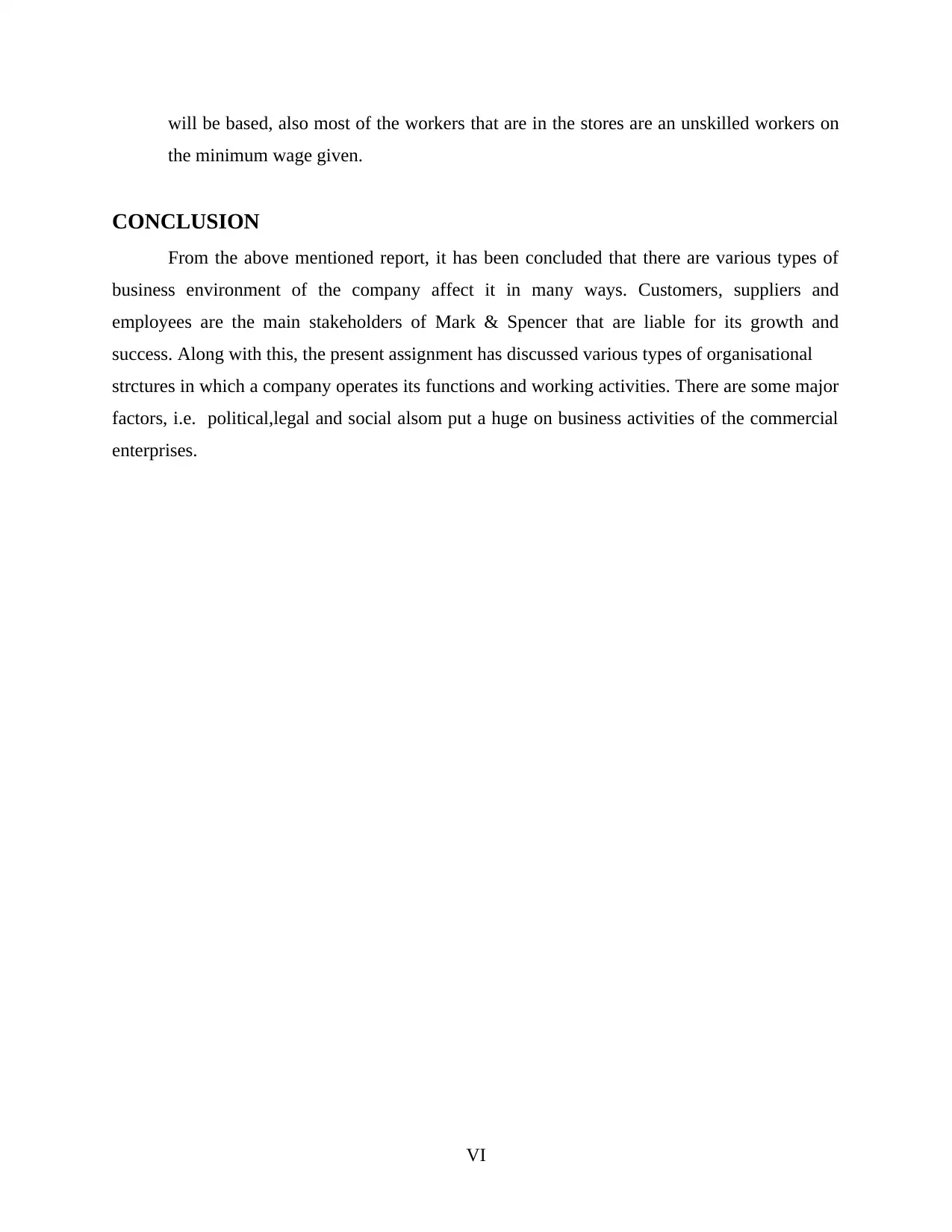
will be based, also most of the workers that are in the stores are an unskilled workers on
the minimum wage given.
CONCLUSION
From the above mentioned report, it has been concluded that there are various types of
business environment of the company affect it in many ways. Customers, suppliers and
employees are the main stakeholders of Mark & Spencer that are liable for its growth and
success. Along with this, the present assignment has discussed various types of organisational
strctures in which a company operates its functions and working activities. There are some major
factors, i.e. political,legal and social alsom put a huge on business activities of the commercial
enterprises.
VI
the minimum wage given.
CONCLUSION
From the above mentioned report, it has been concluded that there are various types of
business environment of the company affect it in many ways. Customers, suppliers and
employees are the main stakeholders of Mark & Spencer that are liable for its growth and
success. Along with this, the present assignment has discussed various types of organisational
strctures in which a company operates its functions and working activities. There are some major
factors, i.e. political,legal and social alsom put a huge on business activities of the commercial
enterprises.
VI
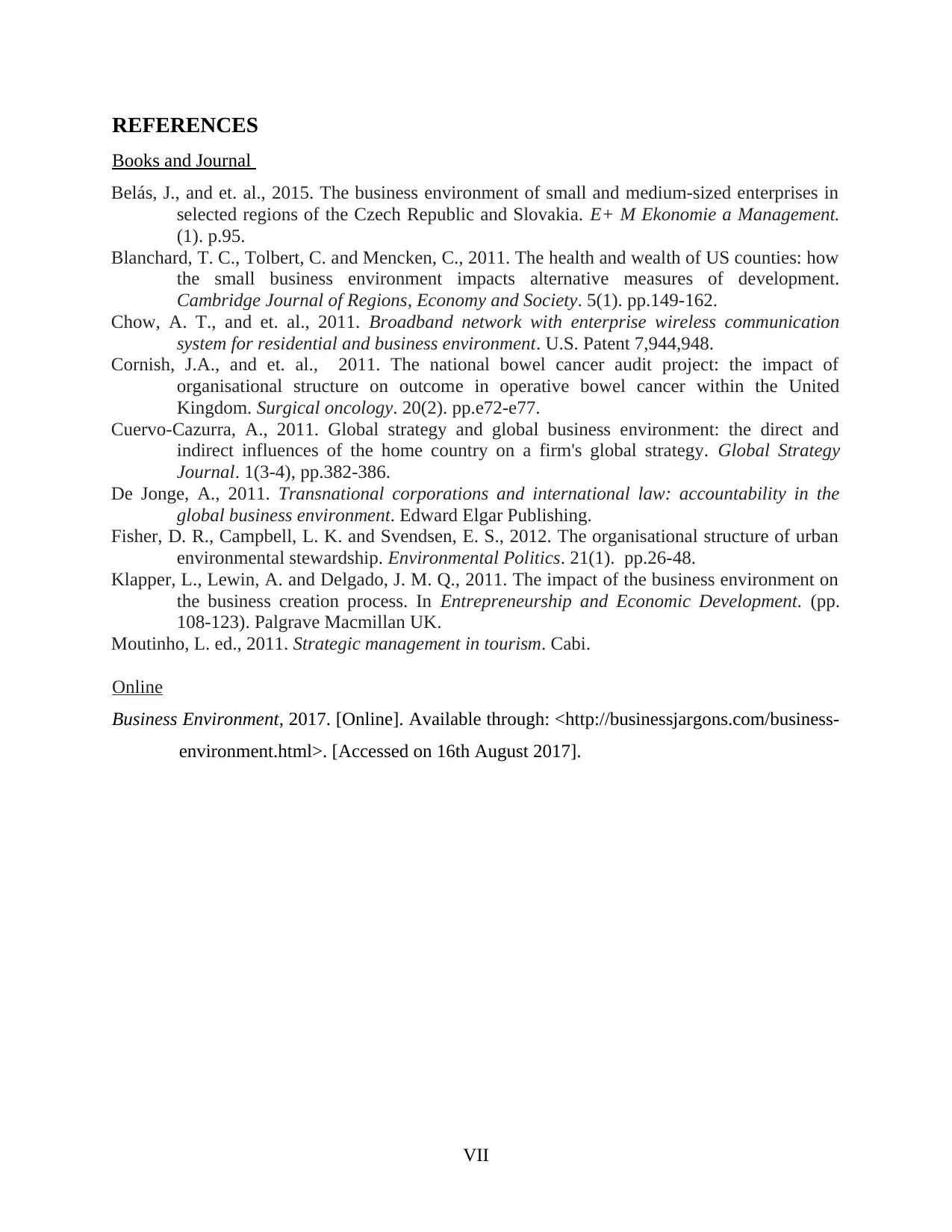
REFERENCES
Books and Journal
Belás, J., and et. al., 2015. The business environment of small and medium-sized enterprises in
selected regions of the Czech Republic and Slovakia. E+ M Ekonomie a Management.
(1). p.95.
Blanchard, T. C., Tolbert, C. and Mencken, C., 2011. The health and wealth of US counties: how
the small business environment impacts alternative measures of development.
Cambridge Journal of Regions, Economy and Society. 5(1). pp.149-162.
Chow, A. T., and et. al., 2011. Broadband network with enterprise wireless communication
system for residential and business environment. U.S. Patent 7,944,948.
Cornish, J.A., and et. al., 2011. The national bowel cancer audit project: the impact of
organisational structure on outcome in operative bowel cancer within the United
Kingdom. Surgical oncology. 20(2). pp.e72-e77.
Cuervo‐Cazurra, A., 2011. Global strategy and global business environment: the direct and
indirect influences of the home country on a firm's global strategy. Global Strategy
Journal. 1(3‐4), pp.382-386.
De Jonge, A., 2011. Transnational corporations and international law: accountability in the
global business environment. Edward Elgar Publishing.
Fisher, D. R., Campbell, L. K. and Svendsen, E. S., 2012. The organisational structure of urban
environmental stewardship. Environmental Politics. 21(1). pp.26-48.
Klapper, L., Lewin, A. and Delgado, J. M. Q., 2011. The impact of the business environment on
the business creation process. In Entrepreneurship and Economic Development. (pp.
108-123). Palgrave Macmillan UK.
Moutinho, L. ed., 2011. Strategic management in tourism. Cabi.
Online
Business Environment, 2017. [Online]. Available through: <http://businessjargons.com/business-
environment.html>. [Accessed on 16th August 2017].
VII
Books and Journal
Belás, J., and et. al., 2015. The business environment of small and medium-sized enterprises in
selected regions of the Czech Republic and Slovakia. E+ M Ekonomie a Management.
(1). p.95.
Blanchard, T. C., Tolbert, C. and Mencken, C., 2011. The health and wealth of US counties: how
the small business environment impacts alternative measures of development.
Cambridge Journal of Regions, Economy and Society. 5(1). pp.149-162.
Chow, A. T., and et. al., 2011. Broadband network with enterprise wireless communication
system for residential and business environment. U.S. Patent 7,944,948.
Cornish, J.A., and et. al., 2011. The national bowel cancer audit project: the impact of
organisational structure on outcome in operative bowel cancer within the United
Kingdom. Surgical oncology. 20(2). pp.e72-e77.
Cuervo‐Cazurra, A., 2011. Global strategy and global business environment: the direct and
indirect influences of the home country on a firm's global strategy. Global Strategy
Journal. 1(3‐4), pp.382-386.
De Jonge, A., 2011. Transnational corporations and international law: accountability in the
global business environment. Edward Elgar Publishing.
Fisher, D. R., Campbell, L. K. and Svendsen, E. S., 2012. The organisational structure of urban
environmental stewardship. Environmental Politics. 21(1). pp.26-48.
Klapper, L., Lewin, A. and Delgado, J. M. Q., 2011. The impact of the business environment on
the business creation process. In Entrepreneurship and Economic Development. (pp.
108-123). Palgrave Macmillan UK.
Moutinho, L. ed., 2011. Strategic management in tourism. Cabi.
Online
Business Environment, 2017. [Online]. Available through: <http://businessjargons.com/business-
environment.html>. [Accessed on 16th August 2017].
VII
⊘ This is a preview!⊘
Do you want full access?
Subscribe today to unlock all pages.

Trusted by 1+ million students worldwide
1 out of 9
Related Documents
Your All-in-One AI-Powered Toolkit for Academic Success.
+13062052269
info@desklib.com
Available 24*7 on WhatsApp / Email
![[object Object]](/_next/static/media/star-bottom.7253800d.svg)
Unlock your academic potential
Copyright © 2020–2025 A2Z Services. All Rights Reserved. Developed and managed by ZUCOL.





